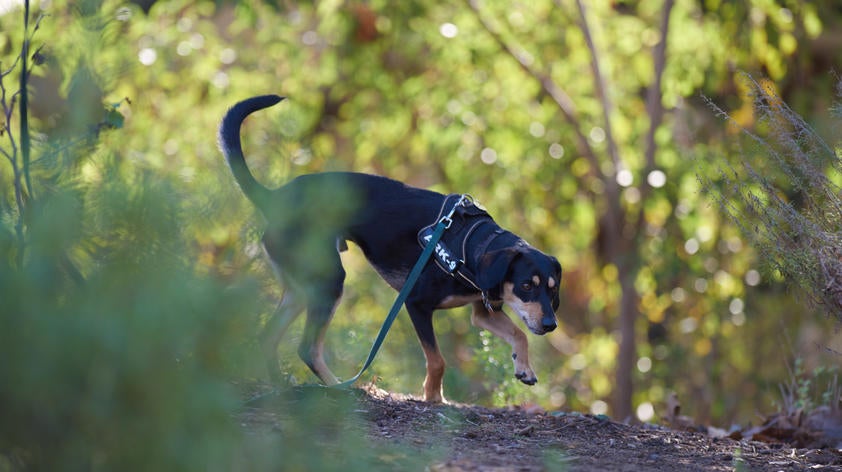
Frog dogs
After reintroducing endangered species into the wild, post-release surveys are a vital step in providing biologists with insight into how movement, disease prevalence and growth rates impact long and short term survival.
However, obtaining these data depends on the ability of the surveyor to visually detect reintroduced animals. This can be challenging when the target species is small, cryptic, well camouflaged, and doesn’t vocalize, as is the case for the mountain yellow-legged frog.
So we’ve had to think outside of the box to find solutions to address the low post-reintroduction detection rates for this frog. Some methods we’ve tested are high-tech, like the long-range pit tag reader, but lack the ability to locate frogs that aren’t tagged.
That’s where the Amphibian Research K9 team, more affectionately known as the “Frog Dogs” come in. What started in 2016 with founding member Luna (a mutt from Mexico) and her handler Dr. Natalie Calatayud, has since grown. Now the current team members include a Chihuahua mix, a Hound mix, a Border collie, and an Australian Shepherd. These dogs are utilizing their innate ability to differentiate an enormous amount of olfactory information in their environment to help researchers find mountain yellow-legged frogs in the wild.
Scent detection canines are well known for being able to detect things such as narcotics, explosives, and missing people. However, their use in conservation programs is becoming more common as their odor detection abilities is as much as 10,000–100,000 times that of the average human, which makes them well suited to finding small (but smelly!) things that are difficult to see like scat, mice, and frogs.
We have now spent almost 4 years working with a former search-and-rescue trainer to teach our dogs to find frogs. Our scent training was designed to be a positive experience for the dogs, which are well compensated for their hard work in the form of high value treats (hot dog, steak, and other goodies) and toys.
Originally we used scent swabs (gauze gently rubbed on the frog’s skin) and water collected from aquariums as the scent source during training exercises, but in 2019 we transitioned to using a live frog from the assurance colony. Additional training involved bringing the dogs to the field sites to get them comfortable walking in stream beds and rugged terrain.
After many training sessions and after passing their “Canine Good Citizen” tests, the dogs were assessed by independent, external, evaluators with extensive experience training scent detection dogs. I am happy to report that all our hard work has paid off! Bighetti (Chihuahua mix), Niko (Hound mix), Darby (Australian Shepherd), and Flynn (Border Collie) all passed the qualification exams (both at the Institute and in the field), demonstrating the ability of the dog and handler team to locate mountain yellow-legged frogs!
The terrain and survey length varies between reintroductions sites, but each dog has traits and abilities that make them more likely to excel at certain locations.
For example, Bighetti, the Chihuahua mix, travels well in a backpack and can be transported up waterfalls, a difficult pursuit for the larger dogs. The larger dogs have their own plus-sides, with more stamina and endurance that will allow them to take on sites that involve a long hike in.
We are eager to have the dogs use their scent detection abilities to smell what we can’t see this field season and are hoping that we can more accurately assess presence or absence of the frogs at various sites within their historical range.













